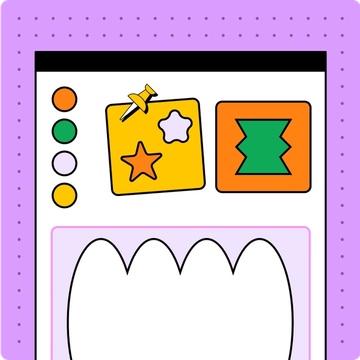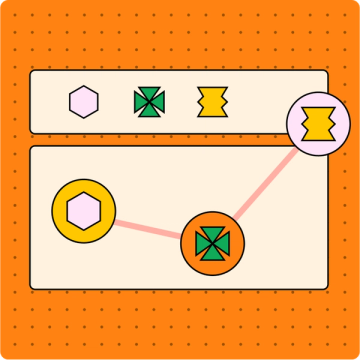How to create a persona

Who are you designing for? What does your target audience like? What are their motivations and frustrations? A persona can help you create better designs, products and experiences to help your users meet their goals. According to HubSpot, personas make websites 100-400% more effective and easier to use.
In this article, we’ll explore tactics and tools that will help you create a persona, turning abstract data into a relatable human user you and your brand can help.
What is a user persona?
A persona is a one- to two-page summary of insights based on qualitative (why or how) and quantitative (how many) data plus external market research. Insights might include core demographics, goals, frustrations, personality traits, and favorite brands—resulting in a mini biography about a person who represents a larger group of your target users.
Ask yourself: “Who is our best buyer?” Answers to this question help your team understand how to market to your customer and shape important strategies like product development roadmaps.
For example, let’s say you have a website that helps people find coupons and rebates for national stores. One of your personas may be “Promo-Code Pat,” a 38-year-old power user on a budget who cross-shops sites to get the best price. They're clever with search terms, love technology, use social media, and ace word games.
By understanding Pat’s goals and behaviors, you and your team can better meet their needs with customer-centric design decisions.

Jumpstart your brainstorming with a free user persona template
Want to start making your user personas? Get started with FigJam's free template today.
Build a persona in 5 steps
The trick to creating a great persona is to start with empathy. Put yourself in the shoes of your user and put their needs first. Your business goals and the amount of detailed data you have will help determine the scope of your persona.
Step 1: Research your users.
Useful personas are based on reliable information from a variety of sources, not hunches or assumptions.
How to research existing users
If you have existing users, you already have access to data to inform your personas. Here's how you can tap rich data sources to build your personas.
- Interview users. Use focus groups, online surveys, or schedule one-on-one conversations to ask your users what they like about your brand and why they use your product or service. To identify trends, speak with at least 10 to 20 people. This is a prime opportunity to learn more about a user’s background, personality traits, and other interests.
- Run a survey. If you’re working with a broad user base, you might run an online survey. Users are more likely to participate if you offer them a discount, store credit, or another reward for their time and honesty.
- Talk to your sales and support teams. Your customer-facing team members have front-line insights into your target audience, including frustrations, pain points, and personality traits. Many companies also record support phone calls with customer consent, and these recordings may reveal key insights.
- Review online analytics. Your traffic data captures demographic and behavioral trends of the users who visit and convert on your website. Google Analytics can also help you create a persona by mapping your customer journey across devices.
- Allow your email subscribers to self-segment. Forbes recommends letting users select their interests and indicate their preferences when completing your marketing permission signup form.
How to apply market research
If you’re starting a business or launching your first digital product, you may not have users yet. In this case, market research can inform your personas. You can study your competitors' customers, purchase 3rd-party research on your target, or check out these free data sources.
Step 2: Identify audience segments.
After gathering and studying research, look for patterns. Your goal is to create a few groups with distinct characteristics. For example, you might find that meditation app users generally fall into one of the following categories:
- High-performing professionals
- Holistic health enthusiasts
- Stay-at-home parents
Aside from a shared passion for your products, you may notice that these customer segments don't have much overlap. That's a useful insight: these differentiated user segments can serve as the basis for three distinct personas.
Brainstorming templates and mind maps are handy tools to sort large amounts of data. FigJam templates help you organize and label trends, leave notes, and host online meetings to share insights and inspiration.
Step 3: Gather background on your personas.
Your research can help you uncover more background information about each persona. With just a few data points, you can get a sense of who this person is and why they’re drawn to your product.
For example, let's call the power user of your meditation app “High-Performance Jamie.” Here’s what Jamie's basic persona might include:
- Demographic 42 years old, married with two kids, affluent suburban zip code
- Education masters degree
- Professional background three years of C-suite executive experience
- Average income $125,000
- Personality traits driven, focused, analytical
- Behavioral attributes wakes up early and uses LinkedIn as primary social media
- Pain points experiences high levels of stress at work
- Frustrations inefficiency, unhealthy habits, working late
- Motivations high performer who sees meditation as essential
Step 4: Start filling in a persona template.
FigJam’s persona template includes prompts for all of the data, traits, and user info you’ll want to capture and share with stakeholders. To expand your persona with more visuals, you can use a moodboard. This visual shorthand helps every stakeholder understand who your users are, how to engage with them, and how to meet and exceed their expectations.
Step 5: Write a brief bio for your personas.
Biographical summaries can bring life and insight to your personas, helping your teams empathize with users and anticipate their behaviors.
Here’s an example based on High-Performance Jamie:
Jaime works at home but is always on the go. Some days, Jamie's only downtime is while driving to appointments, schools and stores. That's when Jamie listens to health and wellness podcasts. To manage stress at work and to reset before engaging with family, Jamie meditates using an app.
Jamie frequently does Pilates, shops at Trader Joes, watches TV using Hulu, and comments on friends' Instagram posts. Jamie is most likely to download apps advertised on Instagram, Hulu, or on health and wellness podcasts.
Once your personas take shape, loop in your team to add detail to the FigJam persona template. As they get to know your personas, they can sculpt workflows and make informed design decisions with these targets in mind.
3 pro tips for interviewing
- Listen for clues. Listen actively, practice empathy, and keep in mind this human psychology insight: people don’t always say what they mean. As an account partner at Saleforce says, “People may not always be able to tell you the root cause of a problem. However, their approach to solving it with workarounds can give clues to a value-based solution.”
- Ask open-ended questions. According to Entrepreneur, open questions can reveal hidden customer insights and deeper stories about their personal experiences.
- Gather cross-functional perspectives. The Journal of Design recommends collecting company-wide business and technical perspectives on personas. This helps set design and build priorities.
Make your next persona with FigJam
Personas transform impersonal data points into people your team can relate to, giving them the insights and empathy needed to inform decision-making, messaging, and product development.
Whether you’re tuning up your brand messaging or refining your product design, FigJam makes design fun again. Find your design inspiration in our customer journey maps, 200+ persona templates designed by our community of design pros, and find your own Figma persona on the Figma Blog.
Ready to showcase your team's creativity, organization, and collaboration?
Sources
[1] https://maze.co/guides/ux-research/qualitative-ux-research-methods/
[2] https://blog.hubspot.com/service/customer-centric-design
[3] https://www.nngroup.com/articles/persona-scope/
[4] https://www.surveymonkey.com/curiosity/offer-survey-incentives-without-sacrificing-good-data/
[6] https://www.entrepreneur.com/growing-a-business/how-to-understand-customer-needs/429343
Keep reading

What is a mood board
Where does inspiration come from? For designers, the answer is usually a mood board.
Learn more

How to make a customer journey map
Learn how customer journey maps can help you sharpen design and marketing efforts, turning casual visitors into passionate brand advocates.
Learn more

How to create a product development roadmap
Get your next product effort off to a running start with a product development plan that clearly maps out your goals, priorities, and timelines.
Learn more




